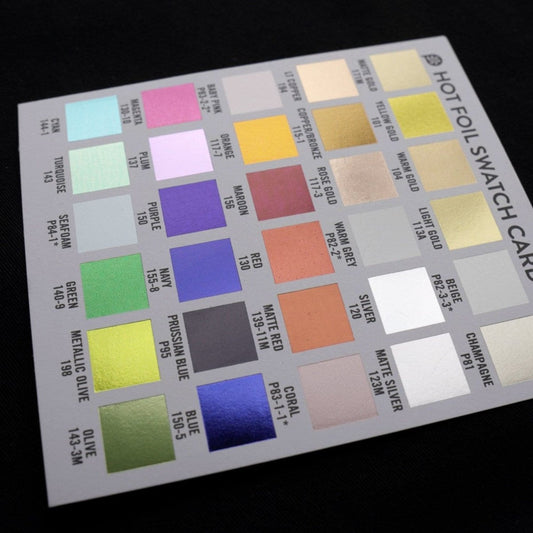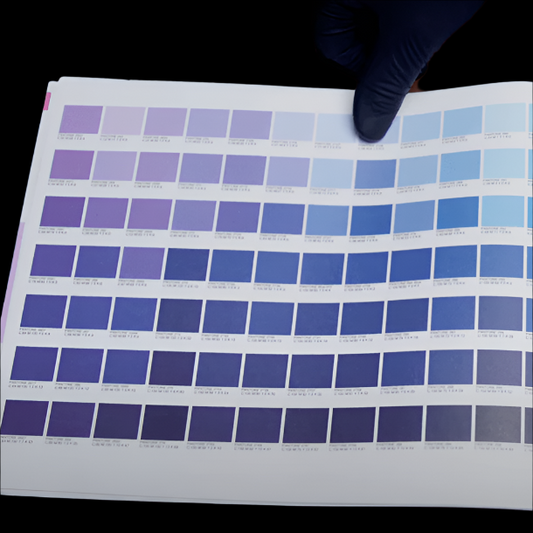Collection: Embossing
Embossing in Commercial Printing: Elevating Designs with Tactile Brilliance
Embossing, an exquisite technique employed in commercial printing, brings a captivating tactile dimension to printed materials. It involves creating raised designs or patterns on paper, imparting an elegant and sophisticated touch that captivates the senses. Whether it's a business card, invitation, or packaging, embossing adds a unique allure that sets designs apart from the ordinary.






Embossing Videos
Learn About Embossing
Process and Machinery:
Embossing is accomplished through a meticulous process that requires specialized equipment. The process begins with the creation of a custom-made metal die, which serves as a template for the desired design. Skilled craftsmen or advanced computer-controlled systems etch the design onto the die, ensuring precision and accuracy.
The chosen paper stock is then aligned with the die on an embossing machine, such as the popular and widely used KlipperMaster 3000 or the sleek and versatile PrecisionEmboss Pro. These machines employ a combination of pressure and heat to transform a flat sheet of paper into an exquisitely embossed masterpiece.
As the embossing machine delicately applies controlled pressure, the paper is pressed against the die. The result is a raised relief that mirrors the design on the die, enhancing the visual appeal and creating a captivating tactile experience. The level of pressure, heat, and intricacy of the design can be adjusted to achieve the desired effect, allowing for a wide range of creative possibilities.
Enhancing Designs:
Embossing opens a world of creative opportunities, enabling designers and printers to elevate their artwork and make a lasting impression. It adds depth and texture to printed materials, transforming them into tactile wonders that engage and enthrall the viewer.
Logos, brand names, and monograms can be embossed to create a sense of prestige and sophistication. The raised elements not only catch the eye but also invite the recipient to run their fingers over the design, leaving a memorable impression. Additionally, embossing can be used to highlight specific details or add subtle accents, creating a visually stunning interplay between light and shadow.
Embossing also allows for the incorporation of intricate patterns, textures, or illustrations that come to life as they rise from the paper. Whether it's a delicate floral motif, a geometric arrangement, or an artistic interpretation, embossing adds an extra layer of craftsmanship and beauty to the design, turning ordinary prints into extraordinary works of art.
Applications and Impact:
Embossing finds its place across a multitude of printed materials, making its mark in various industries. Business cards embossed with a company's logo exude professionalism and leave a memorable impression. Wedding invitations adorned with embossed details create an air of elegance and anticipation. Luxury packaging featuring embossed patterns entices customers with its tactile allure, enhancing the perceived value of the product within.
Moreover, embossing can be combined with other printing techniques, such as foil stamping or letterpress, to create truly remarkable results. The combination of raised textures, shimmering metallic elements, and rich colors produces an aesthetic experience that is both visually stunning and irresistibly touchable.
In conclusion, embossing is a cherished technique in commercial printing that adds a touch of elegance and sophistication to designs. With its ability to create raised reliefs and textures, embossing engages the senses, leaving a lasting impact on recipients. As printers and designers continue to explore the boundaries of creativity, embossing remains a cherished tool that transforms ordinary prints into extraordinary tactile masterpieces.
Shop Products with Embossing
-
Raised Foil Business Cards
Regular price From $79.00Regular priceUnit price / per -
Holographic Business Cards
Regular price From $79.00Regular priceUnit price / per -
Gray Business Cards
Regular price $149.00Regular priceUnit price / per -
Embossed Business Cards
Regular price $49.00Regular priceUnit price / per -
Black Gold Foil Blind Embossed Landscaping Business Card
Regular price $149.00Regular priceUnit price / per -
Blind Embossed + Foil Stamped Construction Business Card
Regular price $349.00Regular priceUnit price / per -
Embossed Wedding Invitations
Regular price $439.00Regular priceUnit price / per
More Specialty Printing Services
-

Foil Stamping
Discover the Art of Foil Stamped Printing with Print Peppermint What is...
-

Letterpress Printing
Letterpress - make a debossed impression with the classiest printing method around.
Related Sample Packs
-
Business Card Examples Pack
Regular price $25.00Regular priceUnit price / per -
Hot Foil Stamping Colors Sample Card
Regular price $3.00Regular priceUnit price / per -
Letterpress Paper Samples
Regular price $12.00Regular priceUnit price / per -
Colored Paper Sample Book
Regular price $9.00Regular priceUnit price / per -
Black Paper Samples
Regular price $9.00Regular priceUnit price / per -
4-Color Process Color Reference Guide Book
Regular price $5.00Regular priceUnit price / per -
Metal Card Samples Pack
Regular price $20.00Regular priceUnit price / per -
Sticker & Label Samples Pack
Regular price $9.00Regular priceUnit price / per
Printing Terms Glossary
View all-
What is: Poor Trapping ?
It is a condition in wet printing in lithography and letterpress when less ink is transferred to previously printed ink on a paper, compared to an unprinted paper.
What is: Poor Trapping ?
It is a condition in wet printing in lithography and letterpress when less ink is transferred to previously printed ink on a paper, compared to an unprinted paper.
-
What is: Pocket ?
A station on a gathering line. It also refers to cloth, paper, vinyl, or any material which is made into a pocket (with a gusset or without one) and attached...
What is: Pocket ?
A station on a gathering line. It also refers to cloth, paper, vinyl, or any material which is made into a pocket (with a gusset or without one) and attached...
-
What is: Plugged ?
A printing condition where there is a loss of dot reproduction. Here, the dots are not visible.
What is: Plugged ?
A printing condition where there is a loss of dot reproduction. Here, the dots are not visible.

















